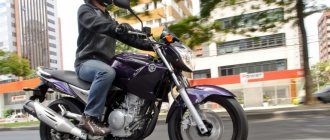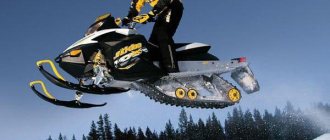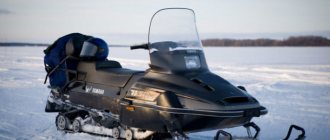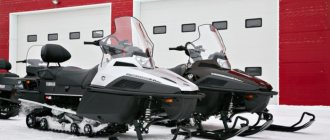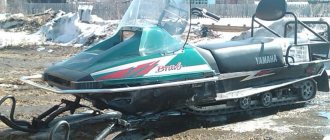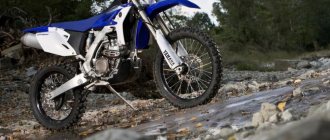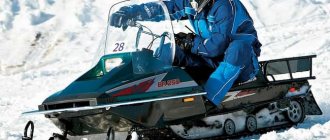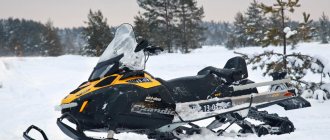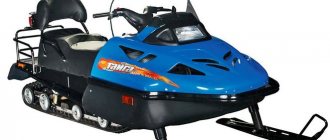Yamaha Phazer MTX is a Japanese-made snowmobile designed for demanding users and professional business owners, as well as lovers of active adventures and walks with family and friends. This model takes into account various improvements that were not characteristic of its predecessors. The designers managed to combine proven technical solutions with innovative technologies, and the result was the Yamaha Phaser MTX snowmobile, which has high potential for off-road driving in harsh climatic conditions. The model in question has successfully passed all factory endurance tests, and has proven itself excellent among owners from Finland, Canada, Europe, Norway, Russia and other countries with a suitable climate. On the one hand, there is nothing ultra-fashionable or high-tech in this snowmobile, but on the other hand, the ideal combination of handling, smoothness, reliability and maintainability has made the car one of the most popular among snowmobiles of the utilitarian and touring class. This is a universal machine, manufactured taking into account the requirements of potential Yamaha customers for whom the above qualities are important. This article presents the design and operation features of the Yamaha Phaser MTX snowmobile, as well as its cost and user reviews.
The snowmobile is made of lightweight materials, which significantly reduce the overall weight of the structure, and thereby improve handling and maneuverability. The developers also managed to strike a balance between handling and cross-country ability to satisfy the needs of commercial fishermen and hunters, as well as professional athletes. So, especially for this purpose, the car received a comfortable driver’s seat, which can accommodate a passenger in the back. At the same time, it is possible to install a backrest for the driver and passenger, as well as turn on heated handles - this option is very useful, for example, in the northern regions of Russia. In addition, the driver will appreciate the electrically heated steering wheel and gas trigger. In general, the driving position is quite comfortable, since the seat is located high, and thanks to this you can move not only while sitting, but also in a standing position, which is very important for professional users and fans of fast driving. Among other ergonomic features, we note the instrument panel, protected from glare on a bright sunny day. In addition, an important advantage is the windshield, increased in height and width. It has an aerodynamic shape and protects the driver from oncoming wind and snow. In addition, this glass increases aerodynamic resistance, and due to this it was possible to improve acceleration characteristics. The seat itself can be adjusted in height, and you can also select settings for the steering column. The seat is covered with a special anti-slip material to reliably fix the driver and passenger in one position, which is very important from a safety point of view, as well as during movement with sharp maneuvers and lane changes. As befits modern snowmobiles, the Yamaha Phaser MTX model has the ability to remove the rear seat and instead install a mounting bar to accommodate additional luggage. In addition, another luggage compartment is provided under the driver's seat. This trunk is reliably sealed and protected from moisture. It can hold various items and accessories, including a refill canister, batteries, spare parts, clothes or food. Also included in the basic package is a rear-mounted tow bar. A sled is connected to it, on which a load is placed. In this case, the Yamaha Phaser MTX snowmobile is “transformed” into a full-fledged mini-truck, capable of moving on a snowy road.
The design of the Yamaha Phaser MTX snowmobile is consistent with the corporate style. This is typical for all flagship cars of the Japanese manufacturer. Despite the lack of newfangled features, the snowmobile has aerodynamic shapes that are present along the entire perimeter of the body. A high aerodynamic effect was achieved despite the fact that the body uses mainly plastic elements that are resistant to damage and frost. Based on this, we can conclude that when fine-tuning the design features, the developers paid more attention not to design, but to aerodynamics, so that excellent acceleration characteristics would not come at the expense of fuel efficiency.
Video
As for the chassis, the developers paid a lot of attention to it, since it bears the maximum load, as does the steering. So, the front chassis of the Yamaha Phaser MTX snowmobile is an independent type design, with two transverse swing arms. The front shock absorbers measure 36 mm in diameter. The shock absorbers are made of aluminum. As for the rear suspension, it is a proprietary Pro Mountain component with beefy rear shocks that are also made from aluminum. The use of lightweight materials (in particular, aluminum) has significantly reduced the overall weight of the snowmobile, while improving handling and maneuverability. In addition, we note the rear suspension travel of 364 mm, thanks to which it was possible to achieve optimal off-road capabilities worthy of this class of snowmobiles. In general, the chassis layout is classic, and includes two front skis, as well as two rear tracks. At the same time, the size of the caterpillar had to be increased to ensure the best directional stability. The ski track is 364 mm.
Braking is provided by hydraulically driven ventilated disc brakes. They have a two-piston caliper design, and are complemented by a mechanical parking brake.
Yamaha Warrior GT
- Look, be careful with the gas! - the instructor admonished. And for good reason: indeed, in response to the slightest touch of the trigger, the snowmobile literally tears out the soles. And when the initial delight of the maniacally fast acceleration wears off, I notice that the Warrior on the move is in many ways similar to the Phazer, although it is positioned as a sports touring snowmobile.
He also strives not to notice irregularities, is also unshakably stable on the trajectory and does not throw up surprises. It’s just that it’s more difficult to take turns under traction due to the elongated track.
If you overdo it with the gas at the exit of a bend, the Warrior straightens its trajectory so actively that you have to make additional efforts to keep it on the track. But in a straight line - delight! And 4 cylinders play their part with the coherence of a string quartet. A true pleasure for the ears!
Specifications
- Engine – petrol, 4-stroke
- Cylinders, pcs. – 2
- Working volume – 0.5 liters
- Cylinder diameter – 77 mm
- Piston stroke – 53 mm
- Engine power output, l. With. – 80
- Brakes – hydraulic, ventilated disc
- Parking brake - mechanical
- Caliper design - two-piston
- Front suspension/shock absorbers – independent/aluminum
- Front suspension travel – 220 mm
- Rear Suspension – Pro Mountain
- Rear suspension travel/rear shock absorbers - 364 mm/aluminum
- Caterpillar dimensions, mm: Width – 356; Length – 3658, Height – 51
- Track brand – Camoplast Maverick
- Ski track/fuel tank volume – 980 mm/26 liters
Basic options: electric starter, reverse, halogen headlights (2 pcs.), heated steering wheel grips with nine positions, heating temperature adjustment, speedometer, tachometer, rear-view mirrors, passenger seat.
Yamaha Phazer R-TX 2015 snowmobile review
Did the Yamaha Phazer concept live up to expectations?
The Yamaha Phazer traces its lineage back to 1984, when the original model with an air-cooled engine and telescopic suspension was released, bringing Yamaha to first place in snowmobile sales. That first model was incredibly successful, gaining popularity due to its lightness, reliability, nimbleness, durability and ability to go almost anywhere. Since 1984, three other versions of the Phazer's successors have been released under this brand.
When the original Phazer began to lose ground and sell poorly, Yamaha introduced the Phazer II. However, it was never able to replicate the success of the original, as by that time Polaris and Arctic Cat had already gained popularity with their Indy and Prowler models. It was the last Phazer to feature telescopic suspension and retired in 1998.
Like the original 1984 Phazer, the 2015 Phazer R-TX is light and nimble on groomed trails.
At the turn of the century (and even the millennium), Yamaha, along with other companies, began producing snowmobiles with their own double A-arm front suspension, including the new air-cooled Phazer 500. It was an inexpensive two-stroke model with the design and chassis of more expensive liquid-cooled machines. This Phazer lasted until 2001, when Yamaha decided to abandon two-stroke engines and switch to four-stroke engines, releasing the new high-performance RX-1 with a liter engine.
Thus, we have reached the modern Phazer models, which are equipped with 500 cc four-stroke twin-cylinder engines. Introduced in 2007, these Phazers were intended to be a reincarnation of the original model, making them affordable, cool sleds that would last. According to the manufacturer, the newest Phazer was supposed to attract the younger generation and beginners to snowmobiling, thereby revitalizing the market, as the original did two decades ago.
The idea was great, and Yamaha designers supported it with original and promising design solutions. The latest Phazer models feature 499cc liquid-cooled four-stroke engines, a unique and smart solution for the snowmobile industry. The new Genesis 80FI engine, developed specifically for the Phazer, produced 80 horsepower between 10,700 and 11,300 rpm. At 8700 rpm the engine produced 84 Newton meters of torque. In order for the clutch to withstand such high engine speeds, Yamaha designers used a variable ratio system that turned the engine's peak 11,000 rpm to the maximum possible for the drive system at 7,700 rpm.
The Phazer's 500cc four-stroke twin-cylinder engine is equipped with dual 43mm Keihin throttle bodies, which are part of a state-of-the-art electronic fuel injection system.
An integral part of this 500 cc engine is a high-tech electronic injection system. It works in tandem with the engine control unit and collects data from five sensors, monitoring parameters such as intake temperature, atmospheric pressure, cam angle, throttle position and engine speed. The engine also has a high compression ratio (12.4:1), which required the development of an automatic decompression system inside the exhaust camshaft. The manufacturer recommends the use of high-quality gasoline, but the Knock Control System engine system sometimes allows the use of gasoline with a lower octane rating.
Yamaha enjoyed a monopoly in the 80 to 100 horsepower four-stroke category until Ski-Doo released its family of sleds with the 90-horsepower ACE 900 engines. The two sled makers compete fiercely in categories like this, where the Yamaha Phazer R-TX competes with the Ski-Doo MXZ TNT ACE 900.
The Phazer R-TX 2015 is a reliable and relatively inexpensive snowmobile. It is a kind of motocross motorcycle on snow. The model is designed for riders with a fairly aggressive riding style who like to ride on rutted trails and configure their snowmobile accordingly.
The Phazer's high, narrow seat allows the driver to move freely and clearly.
With 80 horsepower, the engine can't lift the skis as hard as the three-cylinder Nytro, but the rider can lift the front of the sled by pulling the handlebars toward him and sitting back in the seat, just like on a motocross bike.
The rear suspension of the Phazer R-TX Dual Shock CK with the ability to adjust the preload of the rear torsion spring deserves special mention. The front limit straps can be adjusted to adjust weight transfer, ski pressure and more. The shock package consists of a 36mm high pressure gas and a 40mm combo shock with external reservoir and compression adjuster.
Because the Phazer R-TX rides on a narrow 14-inch (335 mm) Camoplast Ripsaw track that matches the narrow chassis design and riding position, it moves more easily from side to side on corner entry. Again, the behavior of the snowmobile is reminiscent of a motocross bike.
The lightweight FX chassis utilizes Yamaha's proprietary injection molding processes. The drive system is centrally located and the driver sits as far forward as possible.
The Phazer's chassis is narrow, but the designers didn't have to make any compromises. The Phazer FX platform features a unique design created specifically for this sled. It is incredibly lightweight yet durable thanks to the use of unique injection molding techniques and alloy steel.
Some may find the 80-horsepower Phazer too narrow and underpowered, but this sled is all about maneuverability and handling, not horsepower. The design of the snowmobile encourages you to fully squeeze the gas and actively move on the seat. The steering column is straight and high, making it easy to hold the steering wheel while standing. The seat does not interfere with standing control and moving back and forth to transfer weight. The engine is positioned as low as possible, and the drive pulley is located approximately at the level of the driver's knees. Even the exhaust pipe has been moved rearward for optimal weight distribution.
Don't be fooled: the 2015 Phazer R-TX is an incredible bargain and a great sled, even if you don't take the price into account.
Keep the throttle open, trust the sled through turns and ruts, and the R-TX won't disappoint.
What does the newest Phazer have that earlier versions didn't? New for the 2015 model year are Yamaha's Tuner Dual-Keel skis, which can be adjusted to suit your riding style to minimize buffeting and vibration on the snow. The front suspension features Fox Float shock absorbers and lightweight aluminum control arms.
The Phazer R-TX is a worthy successor to the original 1984 model, being an inexpensive, lightweight and fun sled for fun on groomed trails and snowdrifts. New upgrades have made it even more reliable and durable.
The Phazer and Yamaha logos on the sled make it clear that this machine is well built and has everything we love about Yamaha sleds. Button-activated reverse gear, electric starter, comfortable driving position, ventilated disc brakes - all this is often taken for granted on Yamaha models. But all these things come standard with the Phazer R-TX and make it a worthy member of this family of models.
Yamaha Phazer R-TX 2015 Specification | |
| Engine | 4-stroke 2-cylinder Yamaha 499 cc. cm.; cylinder diameter/piston stroke - 77 mm/53.6 mm; liquid cooling system; electronic fuel injection system with two 43 mm throttle bodies. with liquid heating; rear exhaust under the seat |
| Power | 80 l. With. |
| Drive unit | YamahaYXRC; Yamaha |
| Brakes | Hydraulic disc with 2-piston caliper and ventilated disc |
| Front suspension | Yamaha dual A-arms with FoxFloat shocks; stroke - 218 mm. |
| Rear suspension | Yamaha DualShockCKparallel with one 36mm gas shock and one 40mm combo shock with compression adjuster; stroke - 411 mm. |
| Length | 2819 mm. |
| Height | 1341 mm. |
| Width | 1214 mm. |
| Distance between skis | 1079 mm. |
| Caterpillar | 14 x 121 x 1.0 Camoplast Rip Saw |
| Tank capacity | 26.5 l. |
| Equipment | Electric starter, push-button reverse, speedometer/odometer, halogen headlight, one-year factory warranty |
Engine
The Yamaha Phaser MTX snowmobile is equipped with a powerful 80 horsepower engine. This power output is enough to unleash the full potential of the machine, while demonstrating good traction capabilities when driving uphill, as well as in deep snow. The compact four-stroke design is superior to the outdated two-stroke design in many ways. The presence of two cylinders with a total volume of 0.5 liters increased fuel economy and environmental performance. In general, this is a familiar layout for engines of this class. And yet, significant improvements have been introduced specifically for this engine - for example, liquid cooling, which prevents overheating of the power plant at high air temperatures, as well as at maximum engine speeds. In addition, the injection system, which replaced the carburetor fuel system, is important. The cylinder diameter is 77 mm and the piston stroke reaches 53 mm.
What's the result?
As a result, each of the snowmobiles turned out to be good in its own way: Venture is a comfortable family traveler, Phazer is a real conqueror of winding tracks and jumps, an excellent device for “polishing” sports riding skills.
Warrior is ideal for the selfish tourist when you need to make a high-speed throw over a long distance on a relatively flat route (for example, across a frozen lake or along a forest road).
Choose according to your taste and... wallet, since the price difference between the most affordable Phazer in the test and the most expensive Warrior is 140.5 thousand rubles. Something to think about...
Reviews
- Pavel, Primorsky region. This is my first snowmobile. I preferred Yamaha, since people speak mostly positively about this brand. The car really does not bring any unpleasant surprises with reliability; there are no force majeure issues, which is very important on long trips. But in deep snow, the snowmobile quickly digs in and sits on its belly, which is a big disadvantage for such an expensive snowmobile. Yes, and fuel consumption could be less, and the engine makes a lot of noise and vibrates at idle - it feels like it has no sound insulation. The halogen headlight burns out quickly, so you need to take spare parts with you. Minor breakdowns are sometimes annoying, but you have to put up with them, since overall the car is reliable, it handles well and accelerates quickly.
- Igor, Leningrad region. Decent snowmobile for the money. Cost me half a million rubles - almost half the price of the second-generation Professional super-model that my friend has. It’s clear that my snowmobile is not intended for extreme adventures, unlike the Professional, but at the same time it behaves well on any surface - thanks to the large rear suspension travel. The tracks are quite elastic, but are well tuned for comfortable and fast driving both on rolled snow and deep snowdrifts. It is possible to accommodate cargo by removing the passenger seat without the need to install a loaded sled. Although there is a towbar included in the basic configuration, just in case. There is another trunk under the front seat. In general, the car is doing well in terms of practicality. The same goes for the aerodynamic design and economical engine, which is a little noisy at high speeds and also at idle. The windshield is too low, so you can’t do without a helmet, as the headwind and snow will hit your face. The headlight is located high enough, and thanks to this there are no problems with visibility.
- Vladislav, Saratov. The snowmobile is too expensive to maintain. I've been using it for two years. In terms of handling and practicality, this car has no equal among other models equal to its price. But the main disadvantage lies precisely in the cost of ownership, as well as reliability. The rigid suspension easily breaks through, especially if you move off-road, in deep snow, in which serious obstacles are “hidden”. This is very dangerous for such a suspension, but sometimes you still have to drive on such a road - the work requires it. Yes, and sometimes you want to go fishing and go hunting. The Yamaha Phaser MTX model was created rather for the pleasure of handling, driving on smooth and well-worn roads, even with sharp turns. Excellent stability and efficiency, excellent high-torque engine. But the unreliable and breakable suspension greatly impairs cross-country ability. The car consumes 92 and 95 gasoline.
Yamaha Phazer GT
The next race is on the Phazer GT. The fact that it is not only the engine that makes it similar to a motocross motorcycle is clear at first glance. The seat is much narrower than on the imposing Venture. This, of course, does not contribute to particular comfort, but when going through a sharp turn, you can hang from the snowmobile, transferring your body weight inside the turn. In addition, the seat is moved forward as much as possible, and the engine is located almost at the driver’s feet. The result is a near-perfect center of gravity, so that the sled can even stabilize itself in jumps with appropriate rider offset, according to experienced riders, if the takeoff isn't ideal.
The Phazer showed its motocross pedigree already in the first meters of the distance. The complete opposite of the imposing Venture! (Even though the engines are the same.) No tourist smoothness, no thoughtfulness: all reactions are clear, fast, unambiguous, and the snowmobile writes the trajectory with the precision of a compass. Not the slightest extraneous movements! I approached the turn, slowed down, moved my butt inside (sorry, the center of gravity) - and even go through the turn under the traction, even under the throttle, even in a fan: everything is allowed on the Phazer! Phazer rushes along the highway as if across virgin snow, as if hovering over the surface, point-blank not noticing all sorts of bumps and holes.
Being carried away by the ride, I did not notice the small jump that had formed after many races. The speed was too high to slow down in time, and I decided to jump. Naturally, I didn’t approach the springboard perfectly and only managed to stand up on half-bent legs. Breakaway! Phazer soars over the track for a second and falls into a hole behind the springboard, from which it does not leave, but literally jumps out with the caterpillar detaching from the snow.
When the wave of adrenaline subsided, I realized that, firstly, I absolutely did not feel the slightest hint of a suspension breakdown, and secondly, that the snowmobile literally did everything itself. It was not me, but Phazer who performed the jumps in a delicate manner. I finished that lap in a calm mode, since there was still a race on the Warrior GT ahead: 150 forces do not forgive a familiar attitude...


